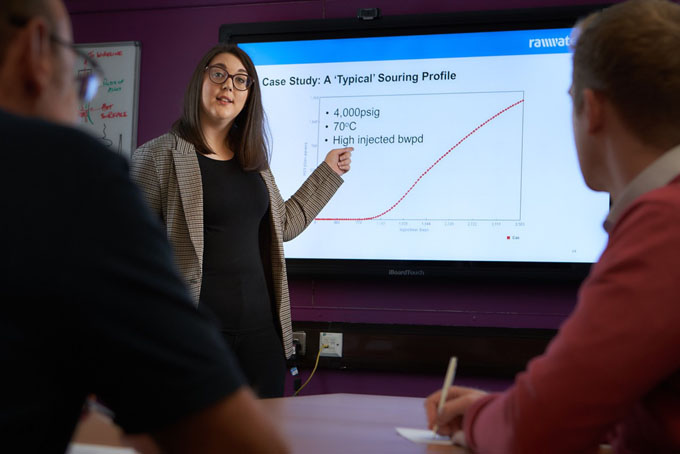
Rawwater, the UK-based specialists in oilfield reservoir souring forecasting, simulation and control, have demonstrated to a leading operator that a costly sulfate removal unit (SRU) will not be needed to mitigate reservoir souring within one of its West African assets.
"Faced with the prospect of investing in excess of $100 million on SRU plant and infrastructure,” comments Rawwater Acting Head of Division, Matt Streets, "the operator wanted, quite rightly, to establish the likelihood of sour gas production from the offshore asset. The main concern was that as the platform in question had been set up for sweet oil service, it would be unable to receive sour fluids from the field. It is also why the operator had already approached a filtration specialist who had recommended that injected water should be processed through an SRU to control microbiological souring.”
Rawwater began by using its industry-benchmarkedDynamicTVS©(TVS = Thermal Viability Shell) predictive oilfield souring modelling tool to complete an exhaustive souring evaluation study. DynamicTVS© considers factors such as oilfield reservoir cooling through water injection, the growth of sulfate-reducing microorganisms (SRM), the flow of sulfide to production facilities, and the partitioning of sulfide species at specified pressure & temperature (P/T) and pH conditions.
"By applying the DynamicTVS© model to data from the West African asset, we were able to show that the P/T conditions within the reservoir were too extreme to support sufficient microbiological growth to lead to sulfide production,” adds Matt Streets. "To corroborate our findings, we then completed a 12-month pressurised bioreactor study at ourUK-based laboratories. The study used native crude oil and was conducted at the same pressures and temperatures as found within the asset. The results of the study confirmed that the crude oil in the asset could only support significant microbiological sulfide production at relatively low pressure and temperature conditions and that the relatively high P/T conditions within the asset would mitigate significant oilfield reservoir souring without need for intervention.
"It is a fact of geology and geochemistry that crude from some oilfields is sweet, whereas from others it is sour,” says Matt Streets. "More expensive to refine, due to higher concentrations of sulfur, sour crude requires the use of corrosion-resistant topsides equipment, expensive sulfate removal technologies and chemical dosing regimens. Geology and geochemistry aside, however, the process of injecting water into reservoirs to maintain pressure during secondary recovery can introduce sulfate-reducing microorganisms into a sweet oil environment. If conditions are right, the result is a phenomenon known as microbiological reservoir souring and the production of highly corrosive hydrogen sulfide (H2S). However, as it can take several years of microbial activity before higher levels of souring are noticed in output, the challenge is to identify the likelihood of souring early enough to establish cost-effective treatment strategies.”
Leading the understanding of microbiological oilfield souring
For more than 30 years, Rawwater has been cultivating oilfield bacteria strains and, today, operates what is widely regarded as the world’s most advanced facility for the study of microbiological oilfield souring under laboratory conditions. Using its DynamicTVS© software modelling capabilities and pressurised bioreactor suites, Rawwater is able to provide certainty to operators with regard to whether or not their oilfield assets will sour – and, where souring is forecasted, the degree of mitigation required.
Rawwater’s software modelling suite, DynamicTVS©, was originally developed at UMIST (The University of Manchester Institute of Science and Technology) and can forecast a reservoir’s propensity to sour in advance of well completion.
Rawwater’s pressurised bioreactor research programme commenced in 2006. The programme was instrumental in the birth of the Seriatim series of work into oilfield souring, with $10 million in funding being set aside for Rawwater to establish a pressurised bioreactor dataset. In October 2021, 15 years after the programme’s start date, Rawwater had built up no fewer than the equivalent of 550 years’ worth of oilfield reservoir pressurised bioreactor data. To date, more than 130 souring forecasts, including single injector/producer (I/P) pair forecasts and full-field statistical analysis, have been completed for clients worldwide.
KeyFacts Energy Industry Directory: Rawwater
 KEYFACT Energy
KEYFACT Energy